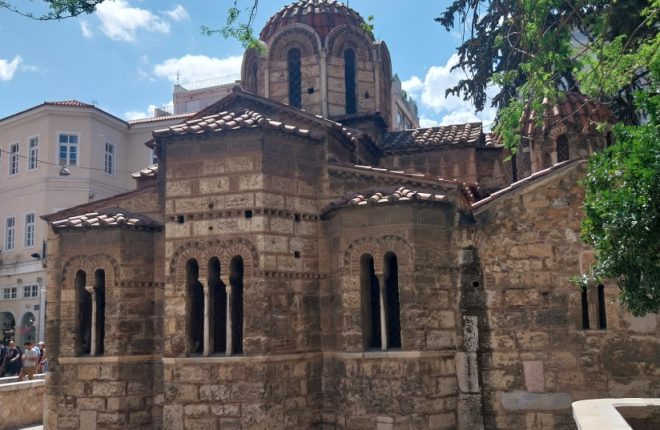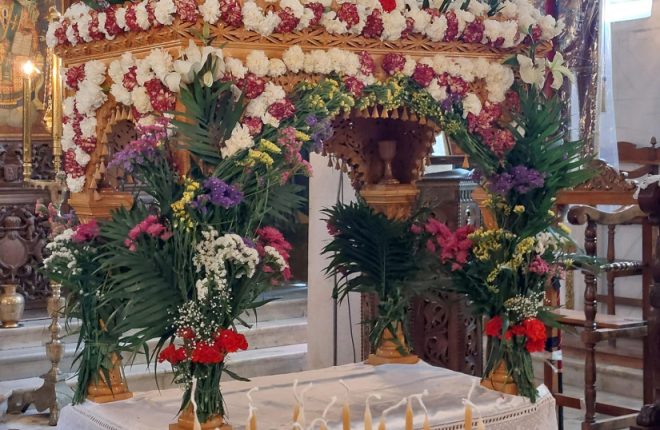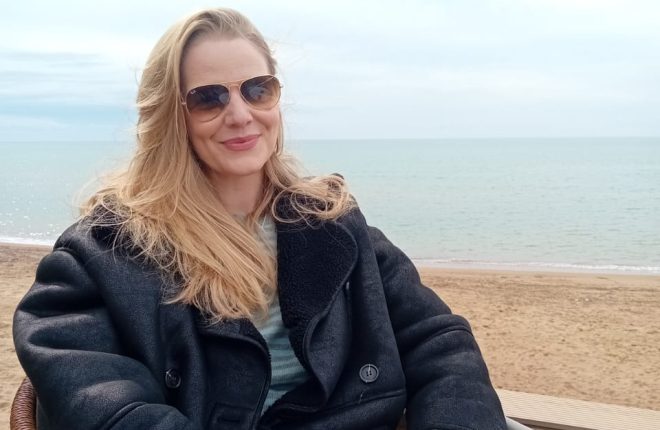Emma Stuart from Manorcunningham spent her Easter in Athens. In a special feature, she tells us how Holy Week brought communities together in prayer, tradition and wonderful celebration.
I moved to Greece last year to pursue my love for a passionate and traditional bushy-bearded Greek man, who I met while visiting Athens in 2023.
Delightedly, he proposed on Valentine’s Day past and the rest is history.
However, the engagement celebrations were short-lived, and the wedding plans were put aside, in order to discuss a much more urgent matter in Greece which takes place in the springtime. Pascha! The Greek Easter, of course, brought very pressing matters that needed to be addressed immediately. How many kilos of lamb intestines should we get? How many kilos of pork? Who will buy the wine and beers?

The church of Panagia Kapnikarea. Ermou Street, Athens, built in the 11th century.
Although not Greek Orthodox myself, I wanted to embrace the rituals and the remembering of the Crucifixion and be a part of it. This is my second time celebrating Greek Easter and I am now one hundred per cent convinced that the Greeks do Easter better than the Irish.
Athens is a beloved city of culture and ancient traditions, of captivating hills and narrow streets. The city itself is named after the goddess of war and wisdom; Athena. Every corner you turn holds secrets of the past. It is like a museum that never closes.
It is a place of beauty where you can’t help but feel happy. Even better, it’s not just a city where you can admire historical ancient monuments and temples, it is also a place for food lovers and coffee drinkers alike to indulge their taste buds, but that’s a story for another time.

An Epitaph in an Orthodox Church for Easter.
Easter is the most important religious occasion for Greeks each year. It is more celebrated than Christmas.
Lent is a time of purification and cleansing. It is a time of renewal. The first day of Lent is known as ‘Clean Monday’ or ‘Kathara Deutera’ as it is called in Greek. Clean Monday is a Bank Holiday in Greece and kickstarts the Easter festivities. On this day, it is traditional to eat fasting foods such as seafood and drink Ouzo. The children alongside their parents fill the parks and outdoor areas flying kites high in the sky.
This custom is thought to symbolise the soul’s path to enlightenment and intimacy with God. The higher your kite flies, the more prosperous the year ahead will be.
For the devout, it is forbidden to eat anything that comes from animals that have blood in their veins during the 50 days leading up to Easter which is known as Lent (similar to the Catholic and Protestant church). However, it isn’t until ‘Megali Evdomada’ which literally means ‘The Big Week’ that most people observe Lent. This is the week from Palm Sunday until Easter Sunday.
This is when the real fun starts. The Orthodox Church reenacts the final week of Jesus’ life during Holy Week, which is essentially a revival of his final days. They centre on Christ’s sufferings prior to his crucifixion. Each day, there are Matins and Divine Liturgy with different themes such as Lazurus Saturday, Palm Sunday and the Liturgy of the Presanctified Gifts.

Odeon of Herodes. An ancient stone Roman theatre found on the slope of the Arcopolis.
Outside of the church, in the Athenian homes, Holy Thursday is all about eggs, bread and cookies. It is customary to boil and dye eggs. They are painted scarlet red to represent the blood that Christ bled on the cross.
It is also traditional to bake bread called ‘Tsoureki’ – a sweet brioche-style loaf that is braided using three pieces of dough, signifying the Holy Trinity. Of course, they must be left until Sunday to be eaten. (However, I couldn’t resist the smell and ate two five minutes after they came out of the oven.)
Little cookies, shaped in coils, braids and twists are also baked. The shapes signify the unbreakable ties of family and faith and perhaps most significantly, they represent spiritual renewal.
Holy Friday begins with the women going to the church with flowers to decorate the ‘Epitaphios’. In the context of liturgies, this is the name of an icon that is typically made of cloth and has colorful elaborate embroidery, and it shows the body of Christ being laid in the grave, by the Virgin Mary and some of his disciples. The icon is then placed on a platform which resembles a four-legged bier, that symbolises the tomb of Jesus which the priest later marches around the church or streets with, while people walk under it and kiss the cloth.
All day, a cacophony of church bells ring in remembrance of Christ’s burial. Many people hold candles and participate in the silent procession, as if it is a real funeral, as if they are mourning a dear friend. The air is filled with melancholy.
For me, it is a rather moving solemn affair and a time of introspection as I remember all my childhood Easters in Donegal that featured around picnics and chocolate egg hunts after a very boring church service.
Holy Saturday is the biggest and most important day of the Holy Week. People flock to their local church in their dozens for a midnight Mass, clutching an unlit candle in their hand. The children have beautiful, animated candles in the shapes of mermaids, lollipops and chocolate bars. Traditionally, the Godparents gift the children their candle and a new pair of shoes for Easter.
We crowd into church. The priest sings the prayers and the hymns and throws perfumed incense all around the church and on the people, not caring if it lands in someone’s eye. This symbolises a beautiful smell that they believe came from Jesus’ tomb on the morning of his resurrection.
Then the lights go out and there is nothing but silence to reflect on the darkness that Jesus endured as he passed through the underworld. At midnight, the priest abruptly reappears with a candle, chanting ‘Christos Anesti’ Christ is Risen, and everyone replies ‘Alithos Anesti’ Truly He Is Risen.

Loving her time in Greece – Emma Stuart from Manorcunningham.
We turn to our friends and loved ones and share a kiss before making our way through the dark crowds to light our candles from the priest’s candle. This is called the holy light, and you must take this back to your home and make a cross shape in the air with the flame as you enter over the threshold.
Fireworks burst into the skies one after the other as church bells ring dramatically. ‘Christos Anesti’ is repeated and chanted and there is a true feeling that something magical has happened here on earth.
Now, Lent is over and traditionally, ‘Magiritsa Soup’ (lamb offal) is eaten on this night. It is not to my taste, but I remind myself of what I have been told many times: ‘It is very simple, if you want the Greek family to accept you must eat and drink everything they make and tell them it is delicious.’
We intentionally wake up early on Easter Sunday morning like kids on Christmas morning. We go to my fiancé’s uncle’s house at 10.30am to spend the day with all the family. The men light the coal on the spit and start preparing the lamb intestines, and pork as well as steaks, burgers and sausages.
By 11am, the festive activities are in full swing as we eat sausages and drink beers, listening to Greek folk music. We play ‘tsougrisma’ with the boiled red eggs. We clink them together to see whose egg will smash first. The cracking of the egg is said to represent the resurrection. The actual feast starts at 2pm even though we are already full. But as the saying goes in Greece, ‘eating is like scratching, you only have to start’. So, we continue.
An array of mouthwatering dishes fills the tables inside and outside; there isn’t enough space in the kitchen for all the food. Spinach pies, cheese pies, potatoes, salads, meats, tzatziki, breads. Then there are the sweets, Galaktoboureko, tiramisu, chocolate brownies, ice-cream and cheesecake.
By 8pm, everyone is exhausted from all the shenanigans, and the party starts to dull down. We go home, and I reflect on the day and the week and feel truly blessed to be on this journey in another country with a new family, to experience other cultures and ancient traditions and to expand my own mind.
Emma Stuart is originally from Manorcunningham. She grew up on a farm with her six siblings, lovely parents and a few Golden Retrievers. She has always had a passion for traveling and foreign cultures. She studied Writing and Literature at ATU Sligo, before doing an M.Phil. in Creative Writing at Trinity College. Emma is currently living in Athens where she is completing a PhD in Language and Communication “and generally just loving life and experiencing new things”.










